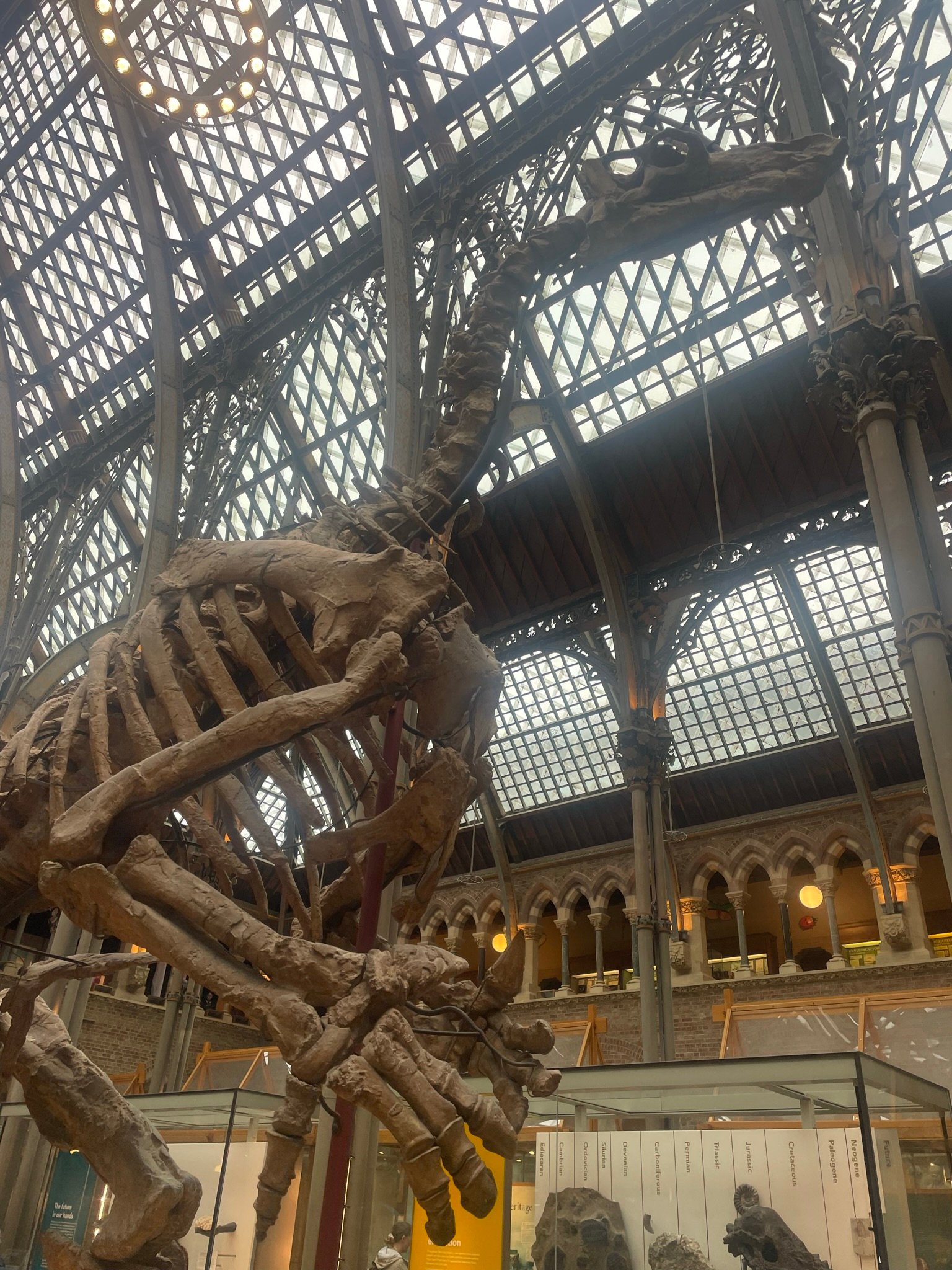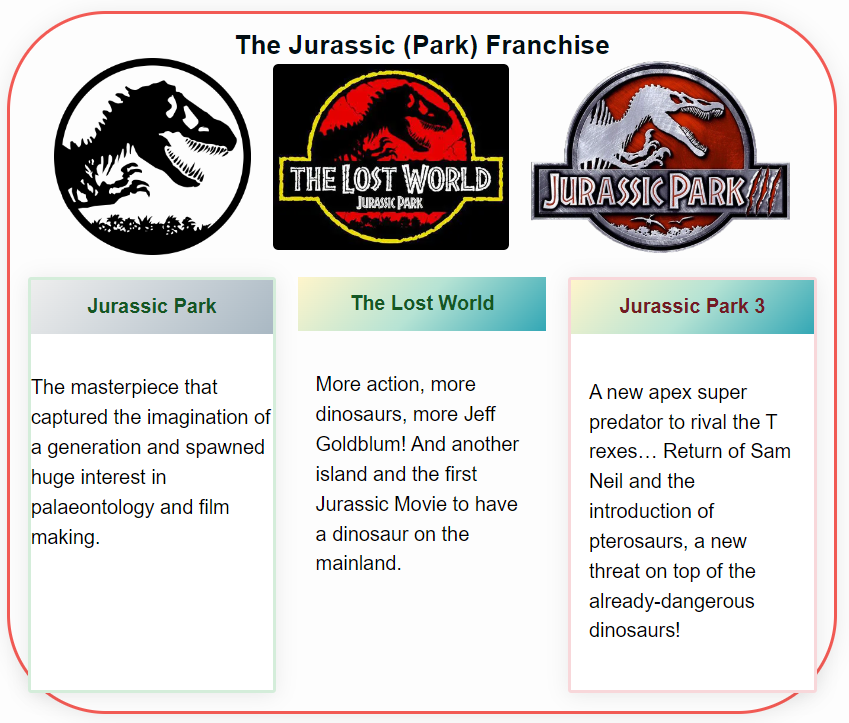We visited the Oxford Natural History Museum on a very wet, rainy day in May and it was so worth it!
As Can Be Seen Above, an Iguanodon is on Prominent Display in the Main Section of the Museum, Right in the Middle!
Behind it was a T rex.
Not just any Tyrannosaur, but Stan: The Second Most Complete Tyrannosaurus Rex Skeleton Ever Discovered.
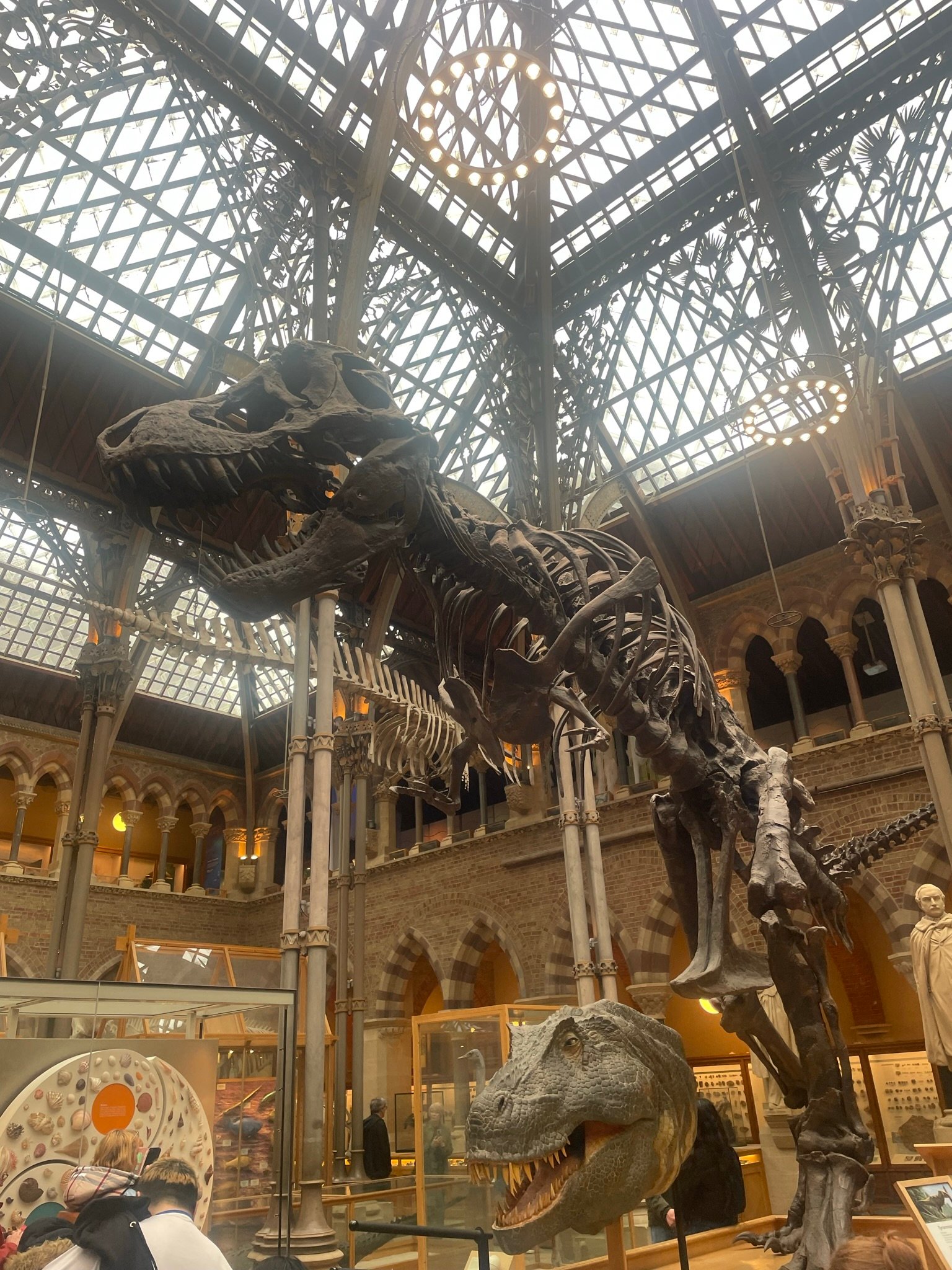

And this was literally as you walk inside the museum!
This page is likely to be best viewed on Desktop or Tablet. It will be fine on Mobile, but the images might be a bit large.
Either way, enjoy!
We happened to visit on Science Saturday, so there were volunteers teaching kids (and us adults) science, from using digital microscopes to see specimens close up, to showing X rays of various skeletons and how they relate to their corresponding animals.
I’ll be honest, we were there mostly for the dinosaurs. And the prehistoric flying reptiles and marine reptiles, of course.
How to Get To Oxford Natural History Museum
We got to the museum by train, and it took us less than 20 minutes (removing the obligatory stops at the nearby Waterstones and other distractions). From the train station, simply walk towards Oxford City Centre and head for Parks Road, around the corner from St Giles.
Typing “Oxford University Museum of Natural History, Parks Rd, OX1 3PW” into your phone will bring you straight to the front door. There is parking but this can be expensive in the middle of Oxford.
If you’re relatively local, there are buses which stop closer to your destination, as they stop in the city centre.
Iguanodon!



In case it isn’t clear in the photos, I’ve included the fact file on display next to the Iguanodon and any other fact files I found:
“Iguanodon bernissartensis
Dinosaur
Cast (skeleton)
Cretaceous Period Sainte-Barbe Clays Formation (130 – 122.5 million years old), Bernissart, Belgium
Our Iguanodon is a cast of one of nearly 30 skeletons that were discovered in a coal mine in Belgium in 1878. They were found 322 metres underground by miners who suddenly discovered they were digging through bone rather than coal.
The specimens were studied by palaeontologist Louis Dollo, who thought that Iguanodon must have walked on two legs because its front legs are shorter than its back legs. Palaeontologists now think that Iguanodon would have walked on all four legs. The bones on the end of the fingers look a bit like hooves, and were therefore well adapted for walking on the ground.”
You Can Learn More about Iguanodon on our Dinosaur Species Profile:
Stan the Tyrannosaurus rex
Meet Stan:

Stan was the second most complete Tyrannosaurus rex skeleton ever discovered. Or rather, so far.
Here’s the fact file on Stan:
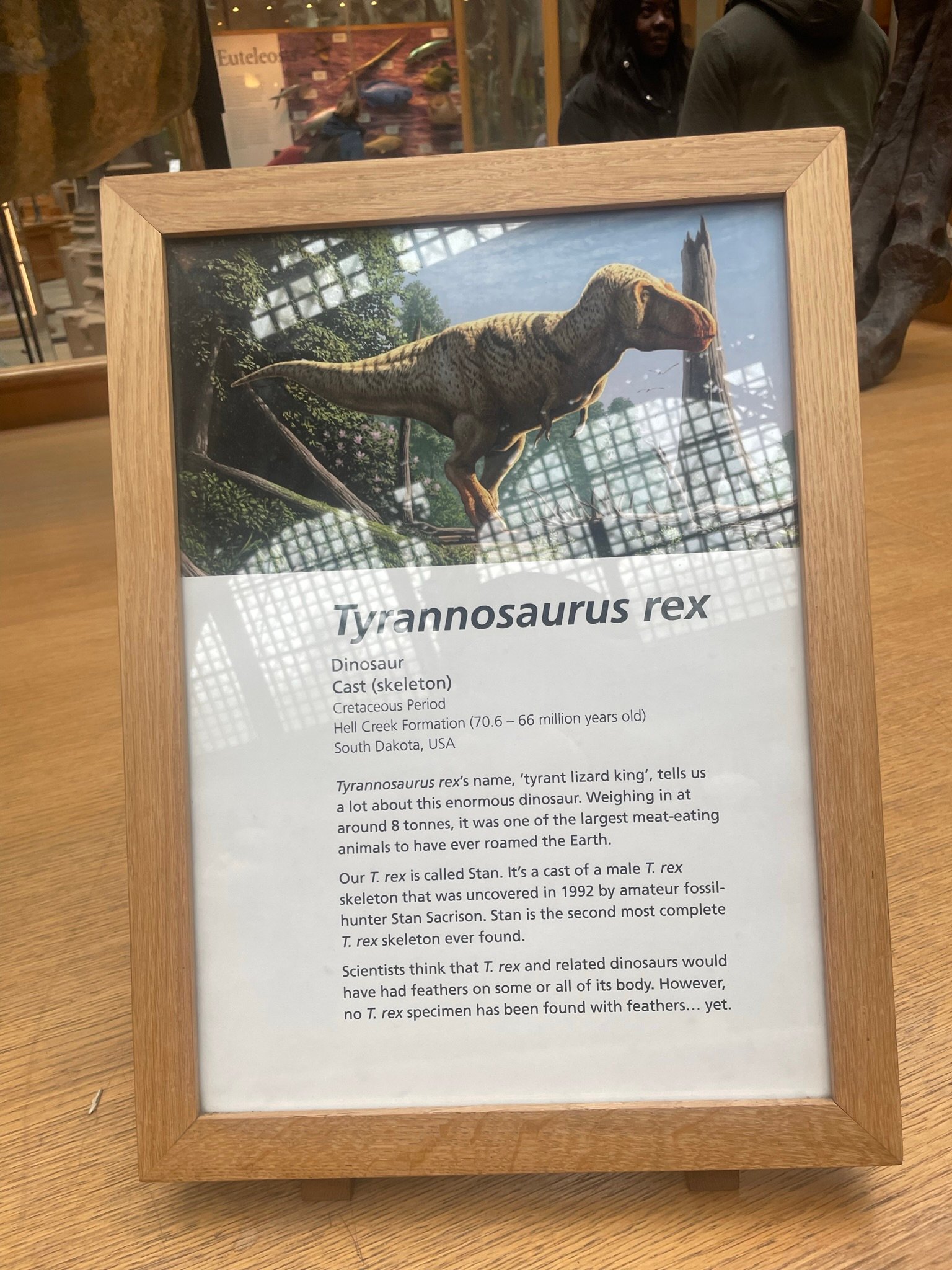
“Tyrannosaurus rex
Dinosaur
Cast (Skeleton)
Cretaceous Period
Hell Creek Formation (70.6 – 66 million years old)
South Dakota, USA
Tyrannosaurus rex’s name, ‘tyrant lizard king’, tells us a lot about this enormous dinosaur. Weighing in at around 8 tonnes, it was one of the largest meat-eating animals to have ever roamed the earth.
Our T. rex is called Stan. It’s a cast of a male T. rex skeleton that was uncovered in 1992 by amateur fossil-hunter Stan Sacrison. Stan is the second most complete T rex skeleton ever found.
Scientists think that T. rex and related dinosaurs would have had feathers on some or all of its body. However, no T. rex specimen has been found with feathers… yet.”
You Can Learn More about Tyrannosaurus Rex on Dinosaur Species Profile:
Other Dinosaurs at the Oxford Natural History Museum
I was pleasantly surprised at the amount of dinosaurs and other, dinosaur associated species such as flying and marine reptiles on display at the Oxford museum.
Compsognathus
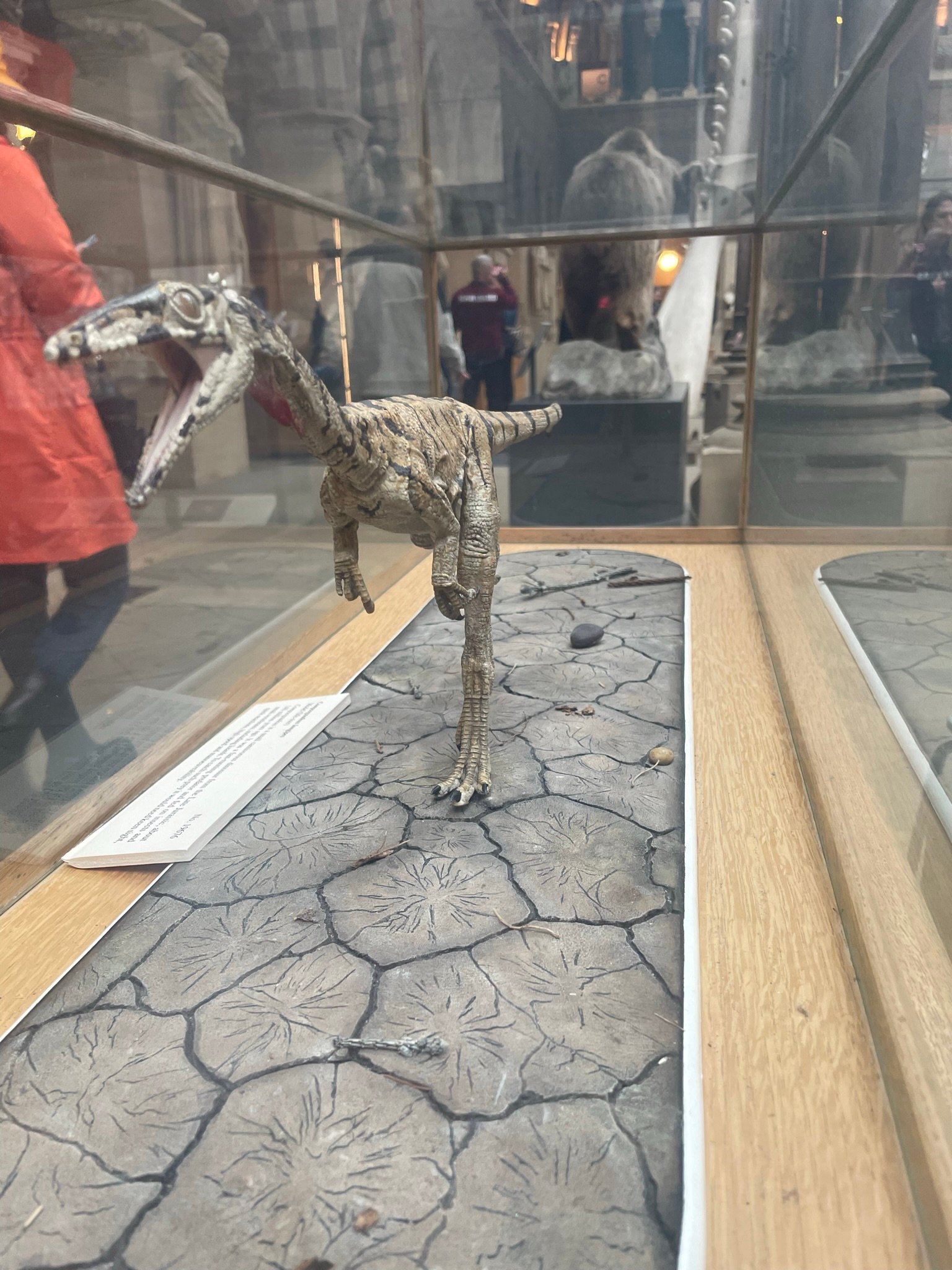
This little chicken-sized dinosaur was in it’s own little display case and could almost be mistaken for a taxidermy specimen. Click the button to check out this compy in more detail:
Allosaurus
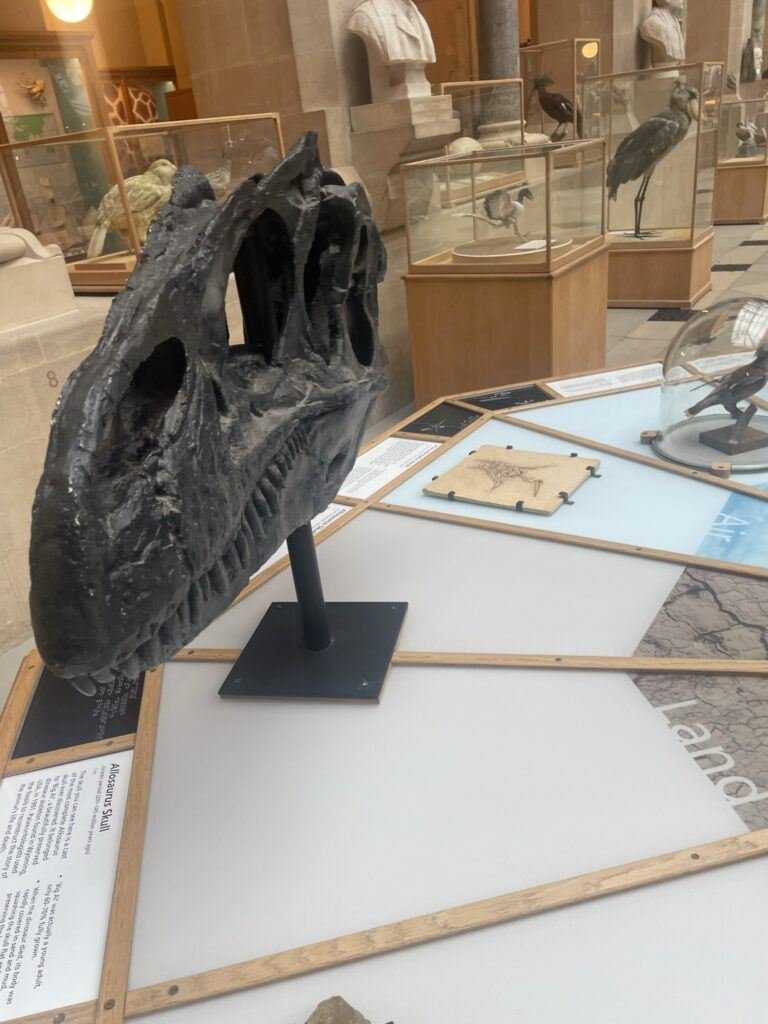
Not quite as popular at T rex, but a mighty medium sized dinosaur nonetheless, the Allosaurus was displayed here in very good detail. Click the button to jump to more Allosaurus:
Pachycephalosaurus
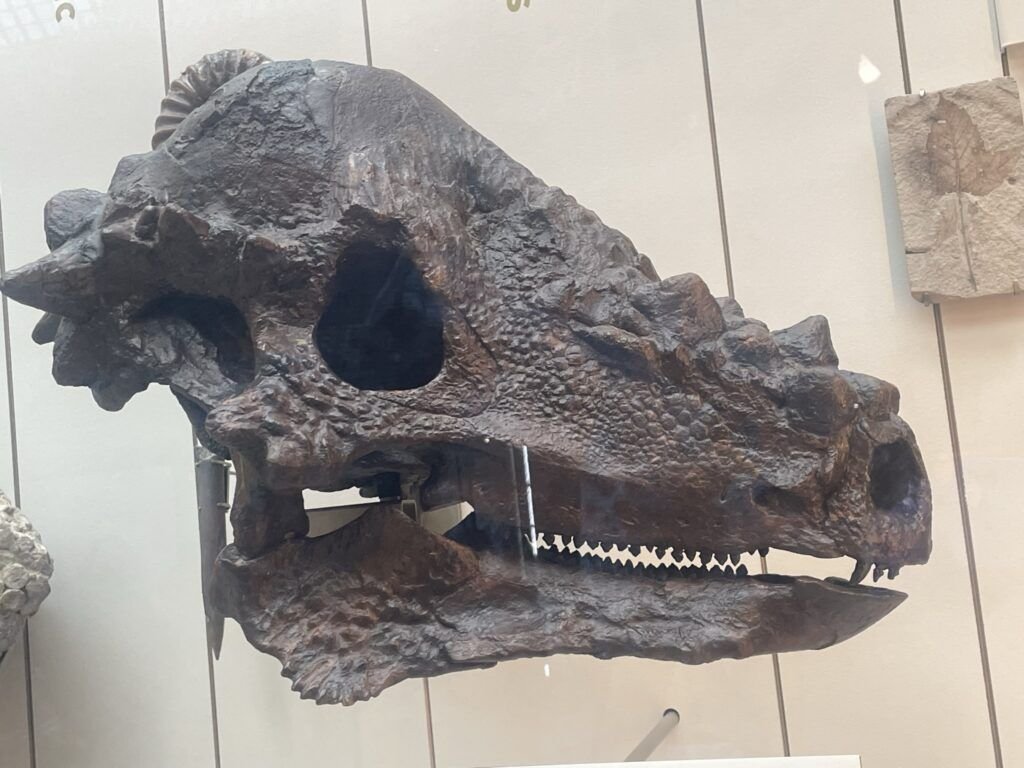
This herbivorous dinosaur has always reminded me of modern day mammals such as rhinos or hippos. With bone that dense, they must have been as dangerous as the predators! Check out Pachycephalosaurus in more detail by clicking the button:
Edmontosaurus

One of the prey items of T rex, Edmontosaurus is a staple dinosaur that fits in with the classic, well known dinosaur species. Click the button to learn more about Edmontosaurus:
Struthiomimus

The long legged, long necked Struthiomimus was impressive to look at: a streamlined ostrich-like dinosaur clearly adapted to running. For more on Struthiomimus, click the button below:
Triceratops Horridus
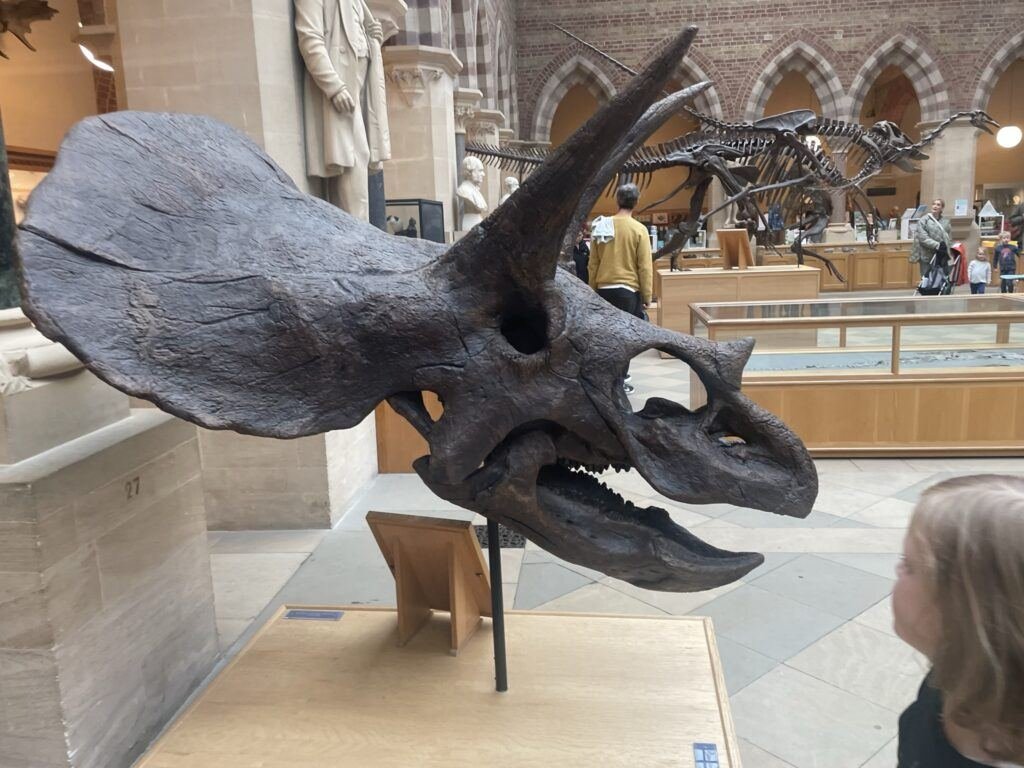
One of the most striking and famous of all the dinosaurs, the Triceratops skull here shows how it was so formidable and was able to stand up to its predatory counterparts. On display at the side of the museum and between the other herbivorous dinosaurs and marine reptiles, this skull really catches the eye.
For more on Triceratops, click the button below:
Bambiraptor

Since this was on display alongside Tyrannosaurus Rex, I honestly mistook this for a juvenile Tyrannosaur at first. With an adorable name, this fierce little dinosaur looks ferocious, especially if you happen to be anything smaller than a turkey. Check out more on Bambiraptor by clicking the button below:
Non-Dinosaur Groups and Species at Oxford Natural History Museum
Prehistoric Marine Reptiles

There was a vast amount of prehistoric marine life at this museum, and some brilliant displays of ancient marine reptiles. For more on marine reptiles, click the button below:
Prehistoric Flying Reptiles

The display of prehistoric flying reptiles really showed the variety of creatures that owned the skies. For more on prehistoric flying reptiles, click the button below:
Early Mammals

An often-overlooked aspect of the time of the dinosaurs are early mammals, and they’re covered at the Oxford Natural History Museum! For more on early mammals, click the button below:
More Oxford Natural History Museum Dinosaur Photos
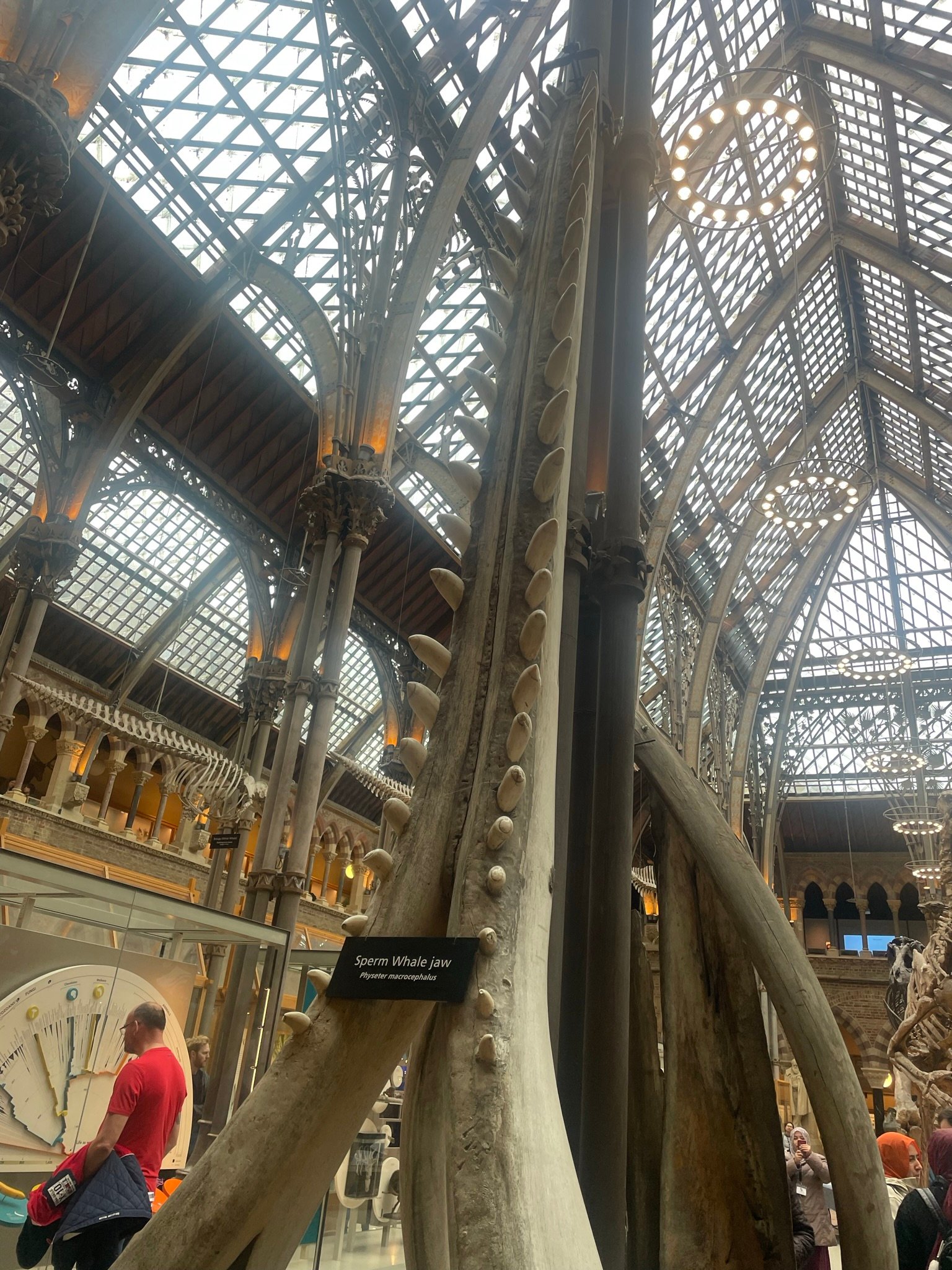

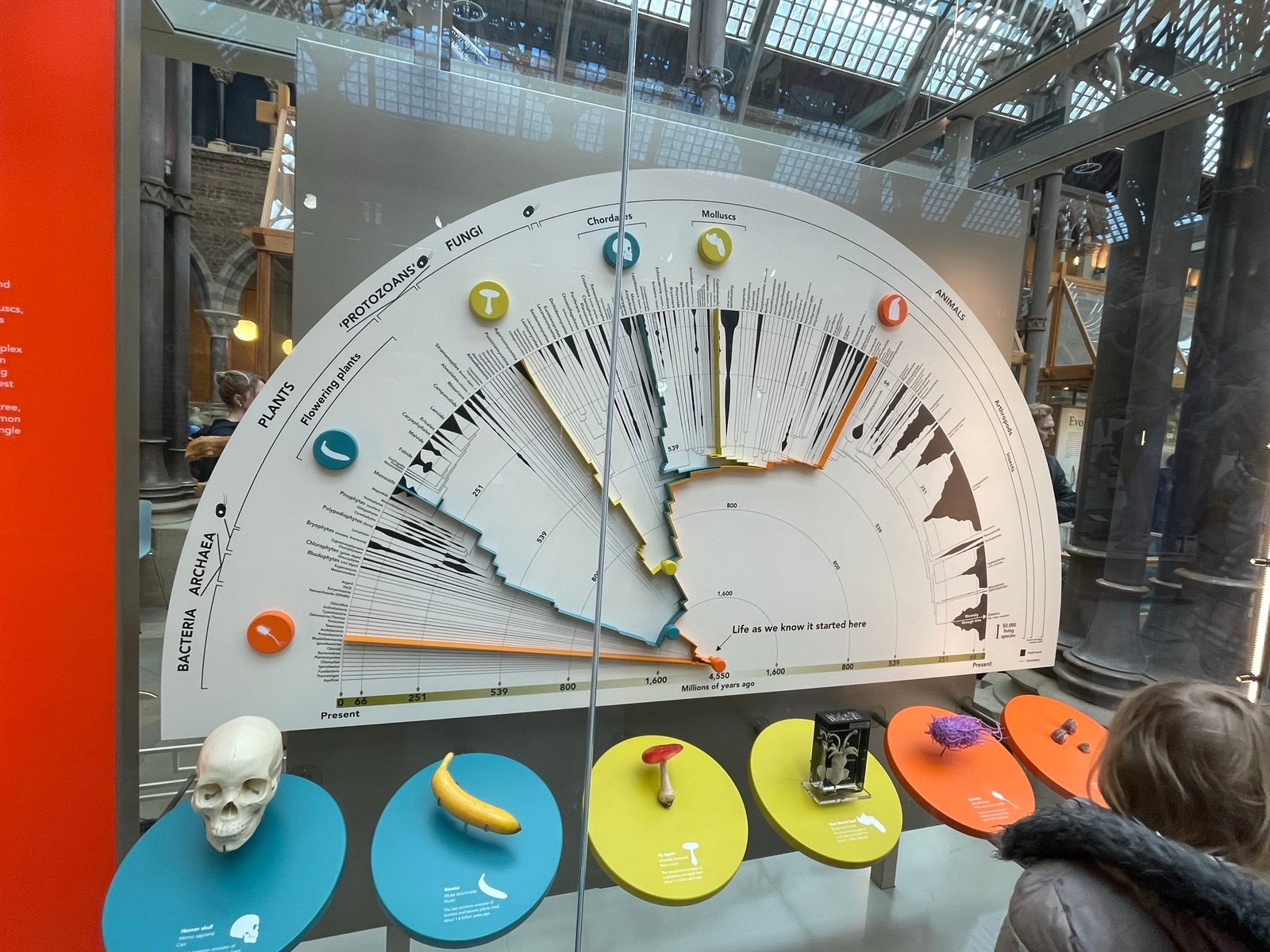
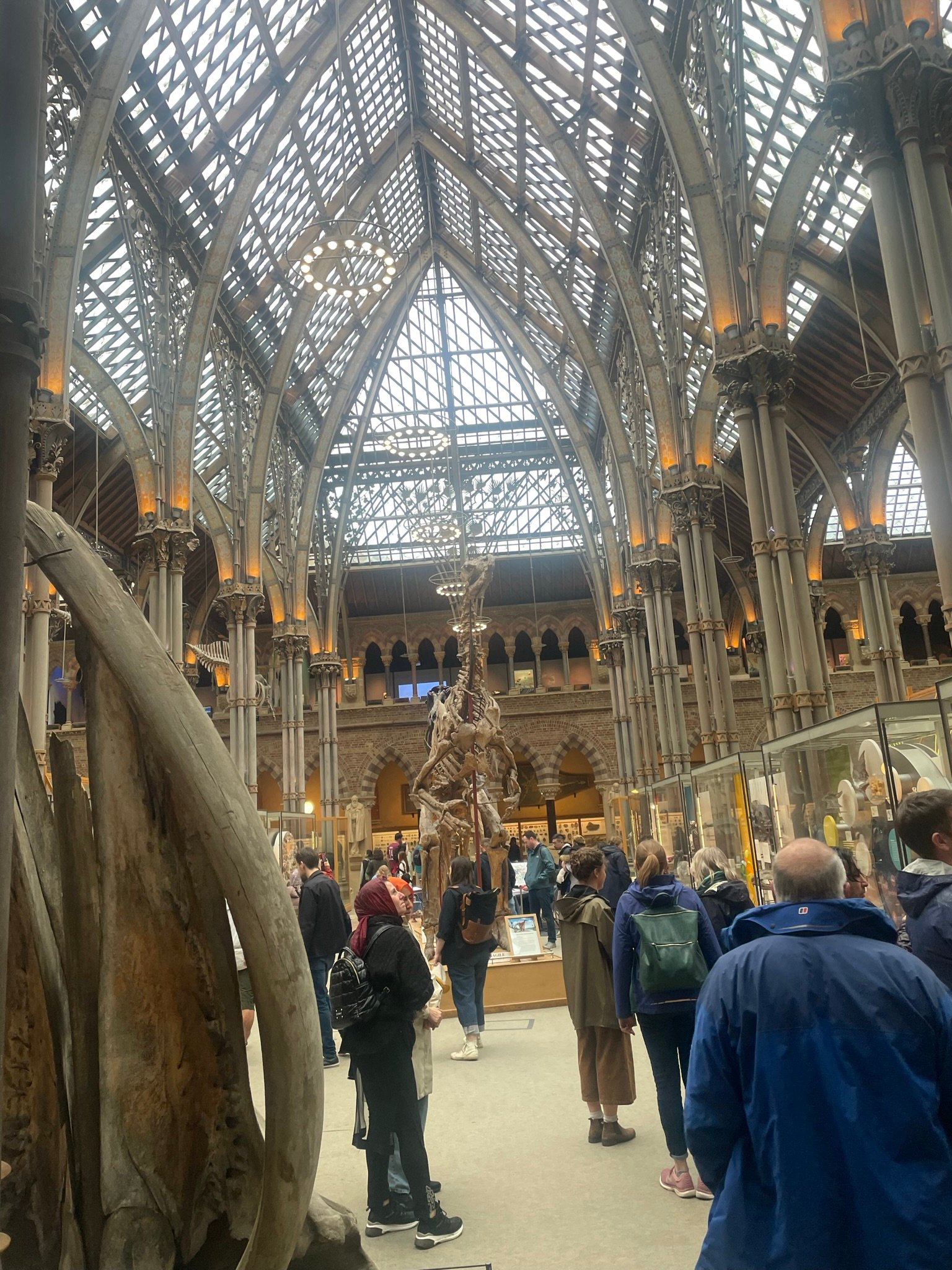
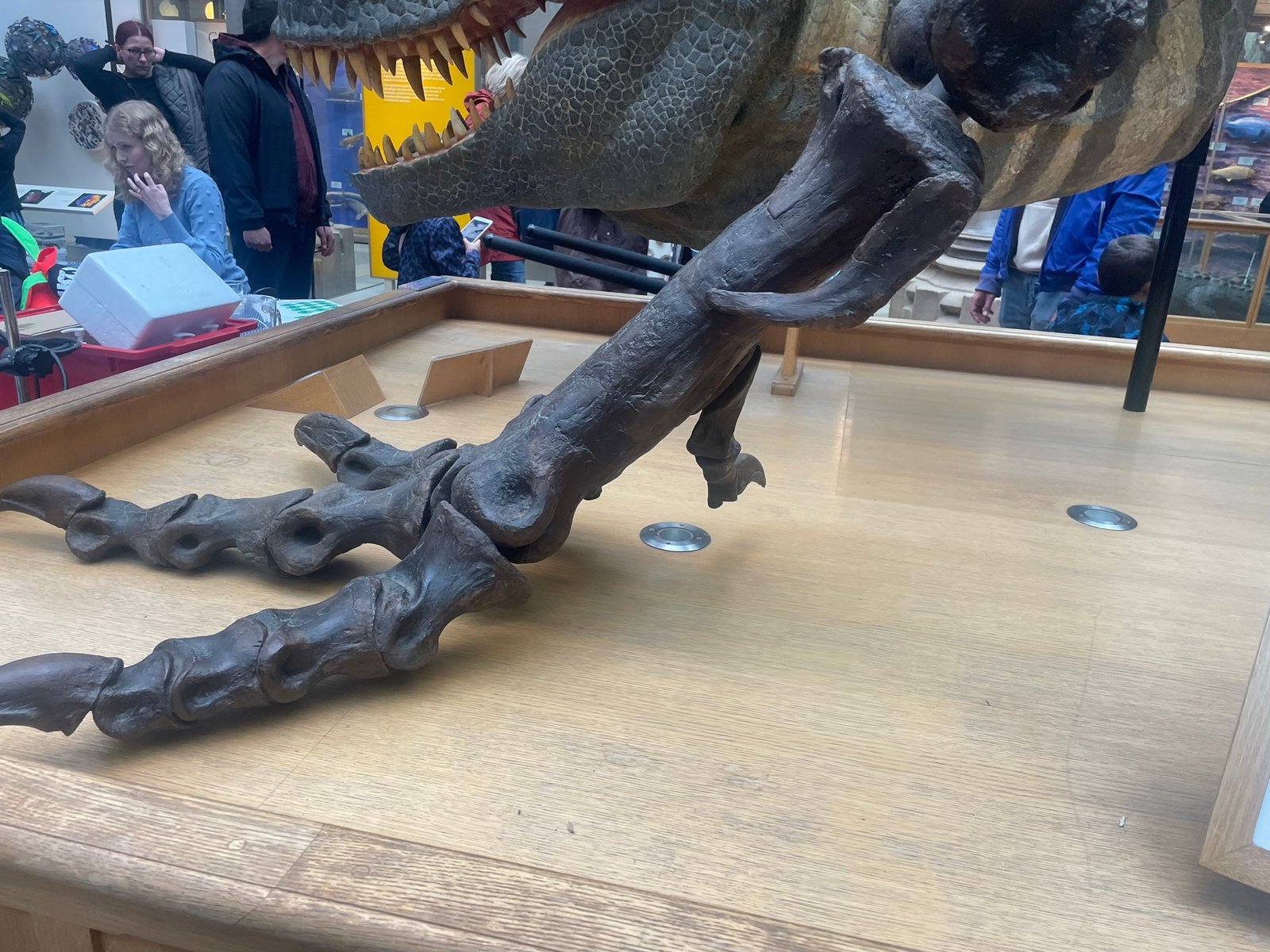
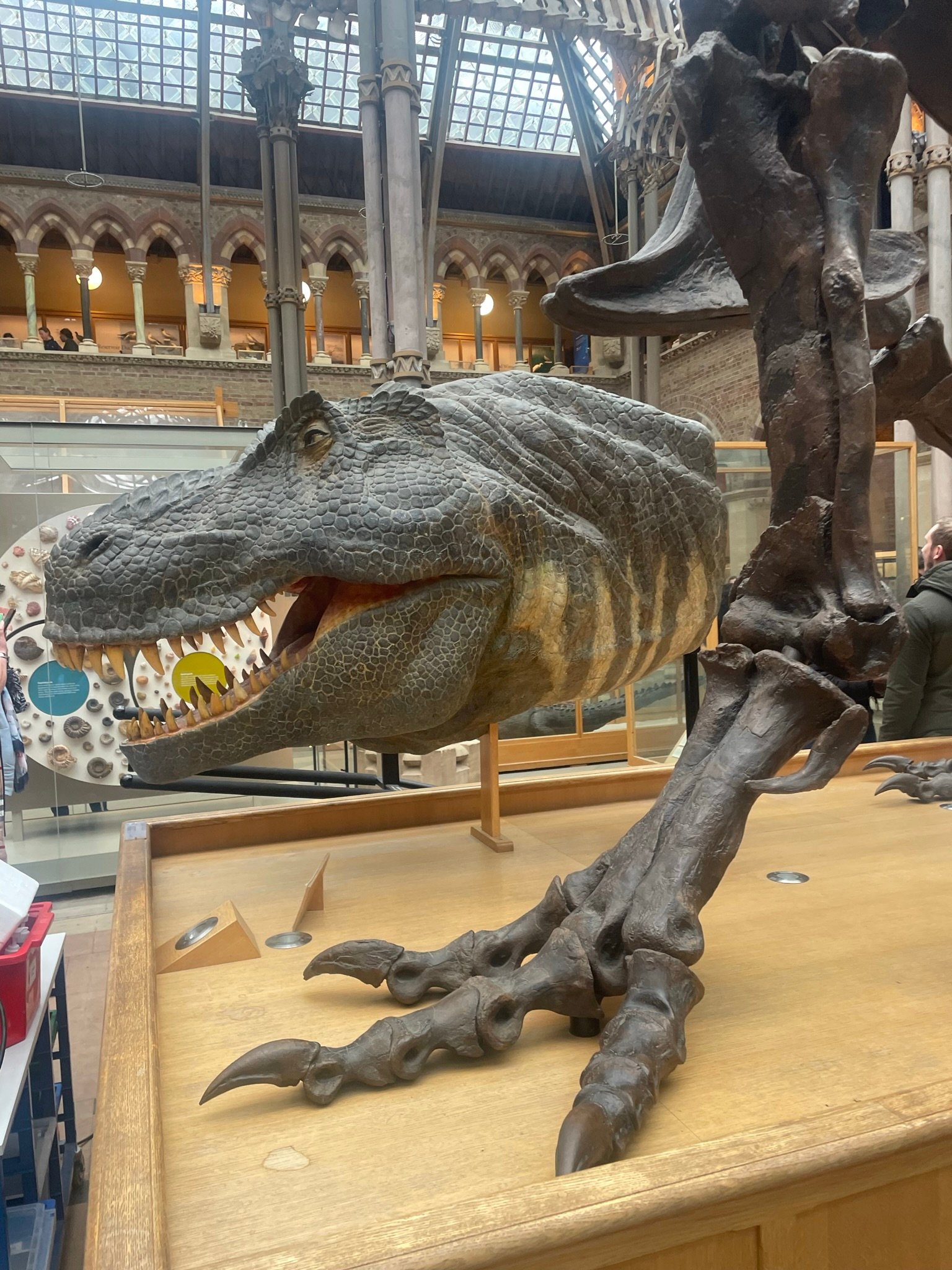
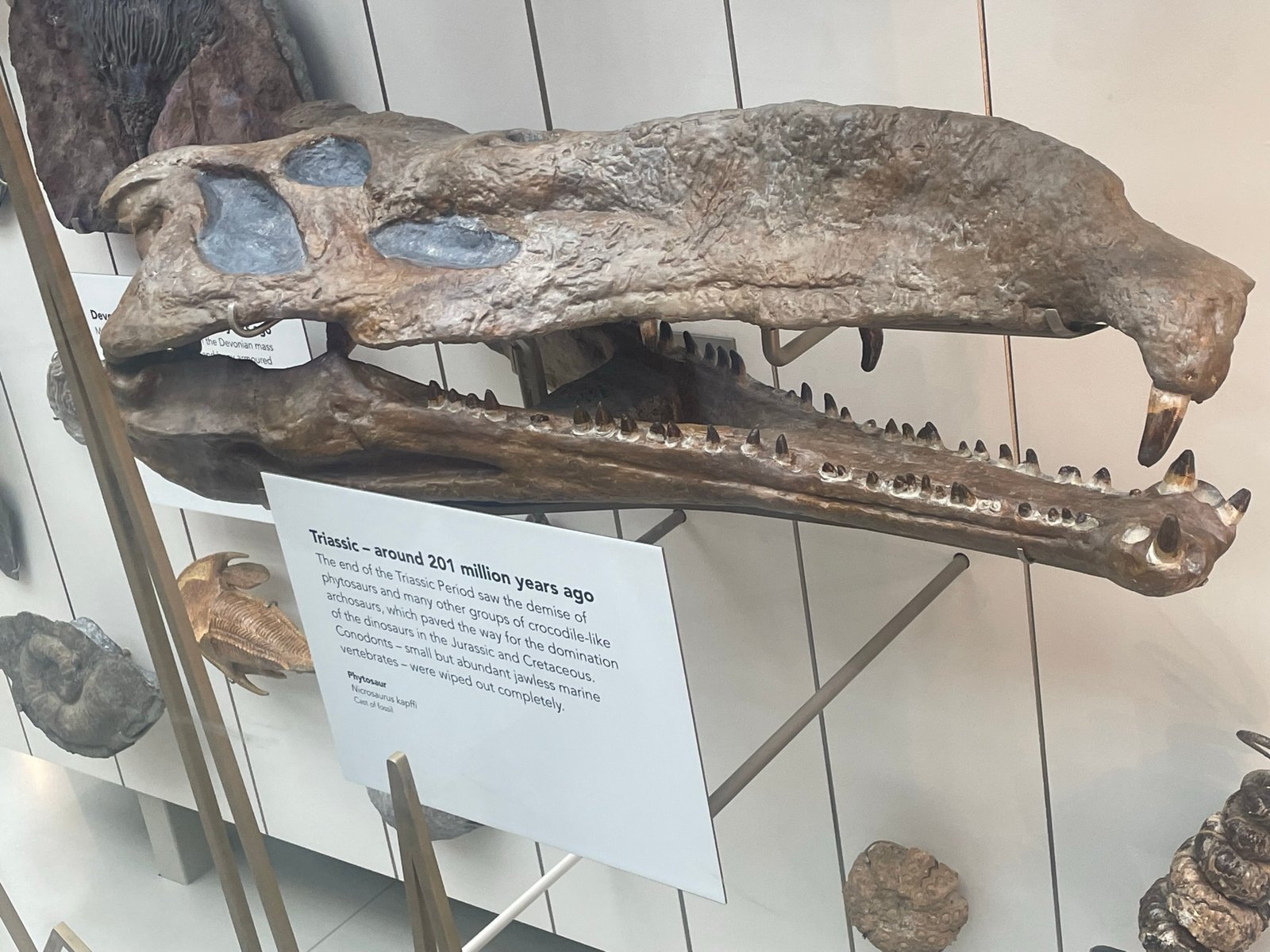
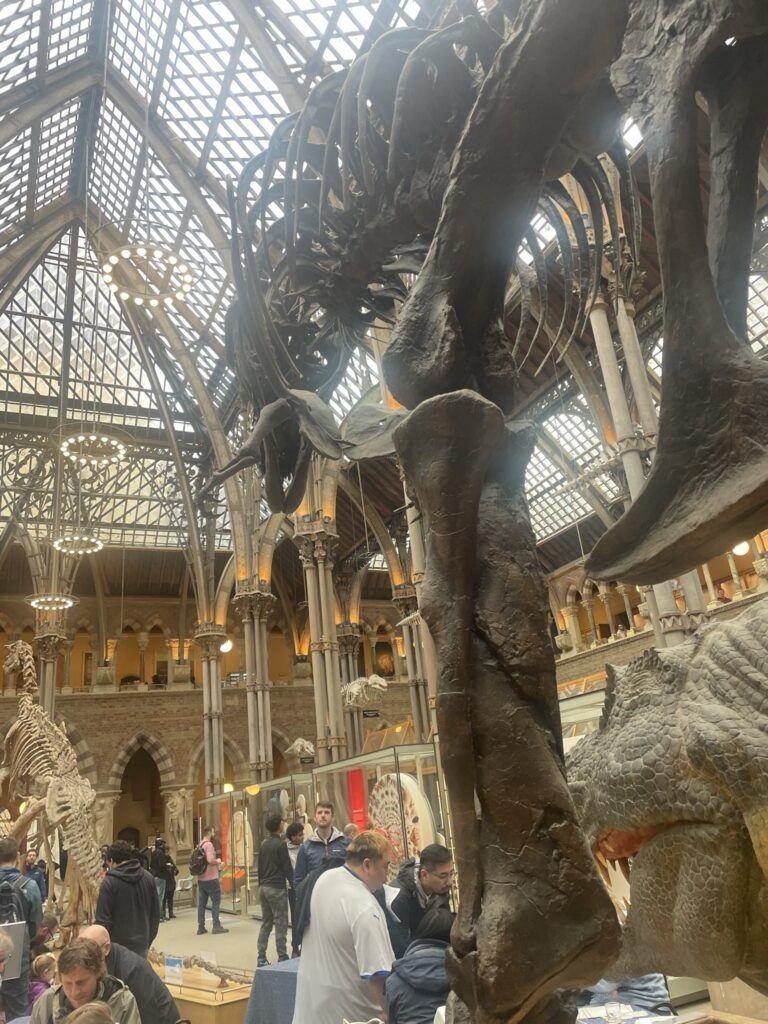
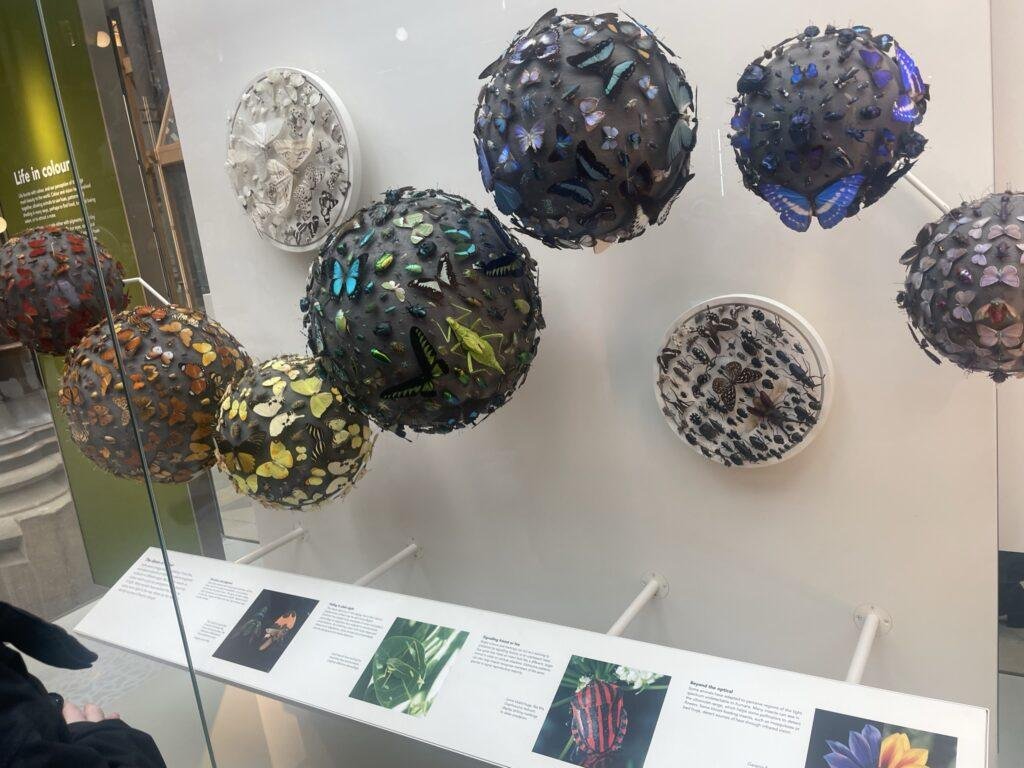

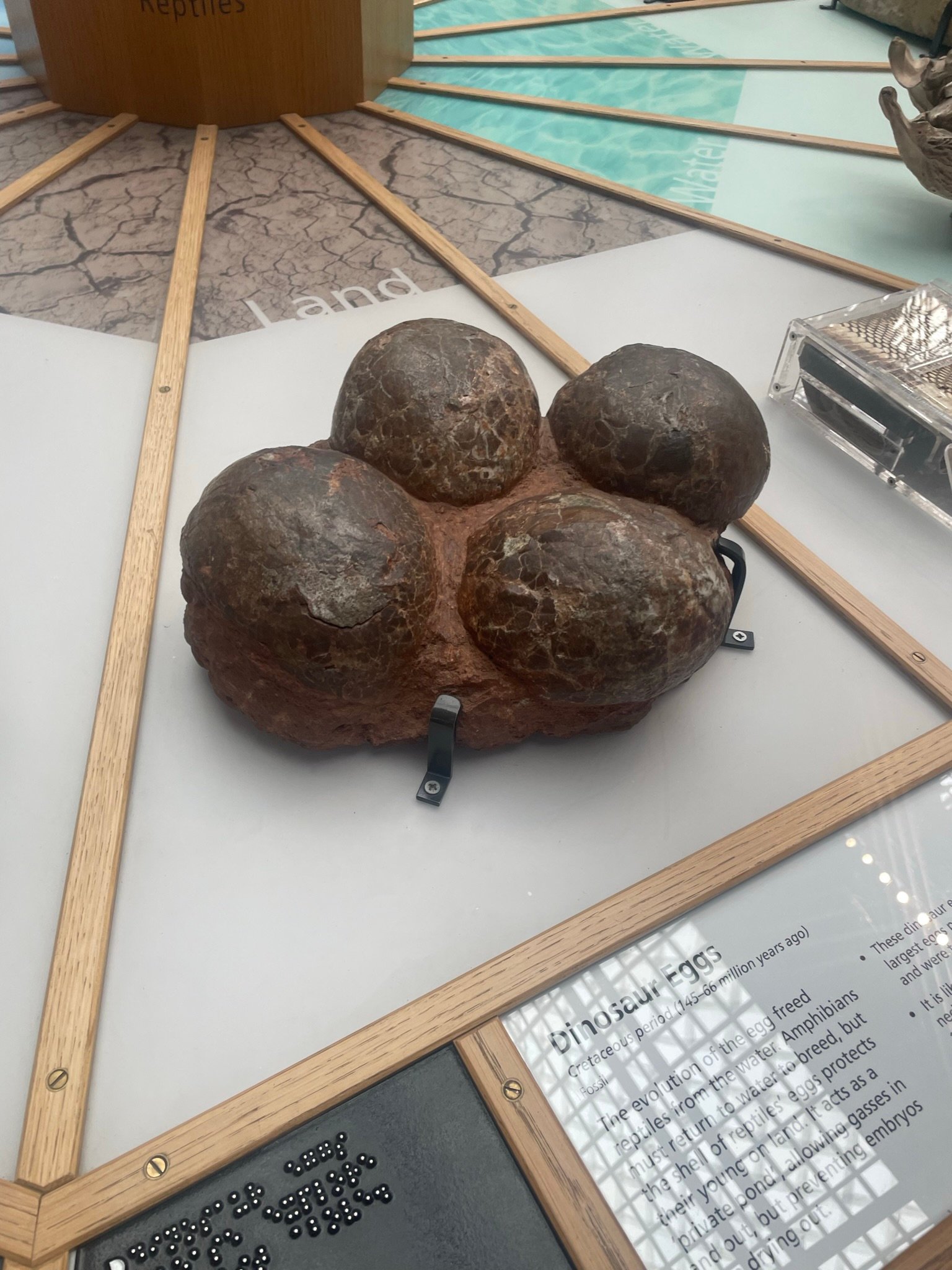




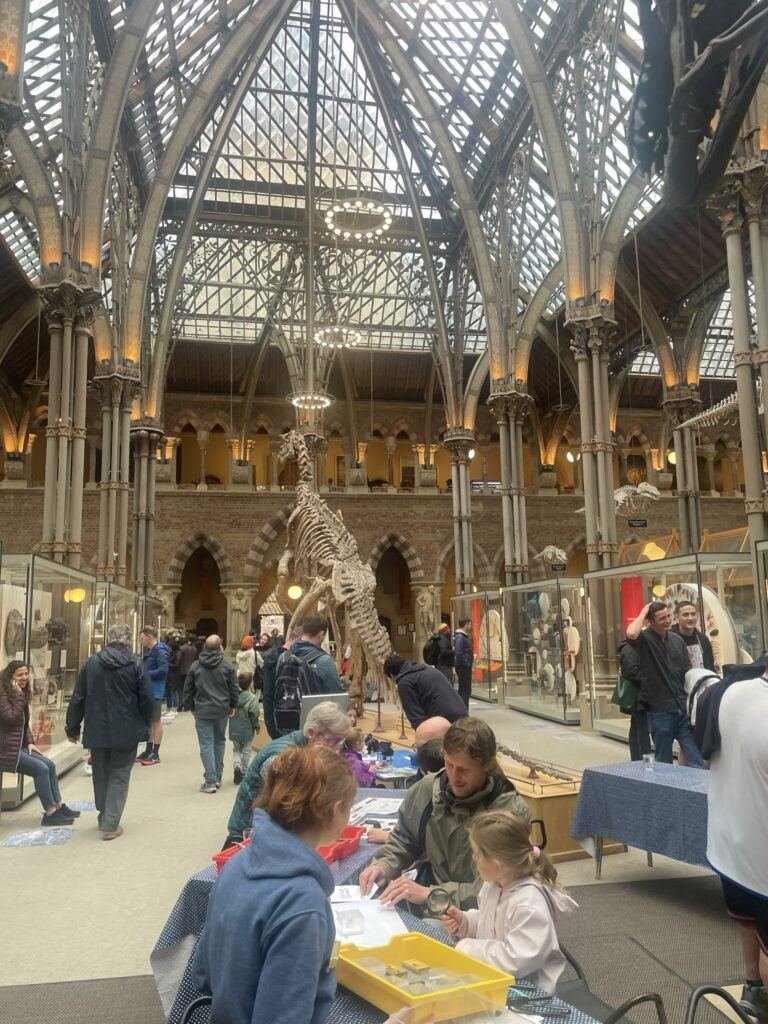
Compsognathus
This little dinosaur is a great example of how dinosaurs during the Mesozoic era took up every niche, from the absolutely huge predators and canopy-grazing, enormous herbivores to the smallest of the chicken-sized dinosaurs that would have fed on insects, small mammals and possibly even carcasses.
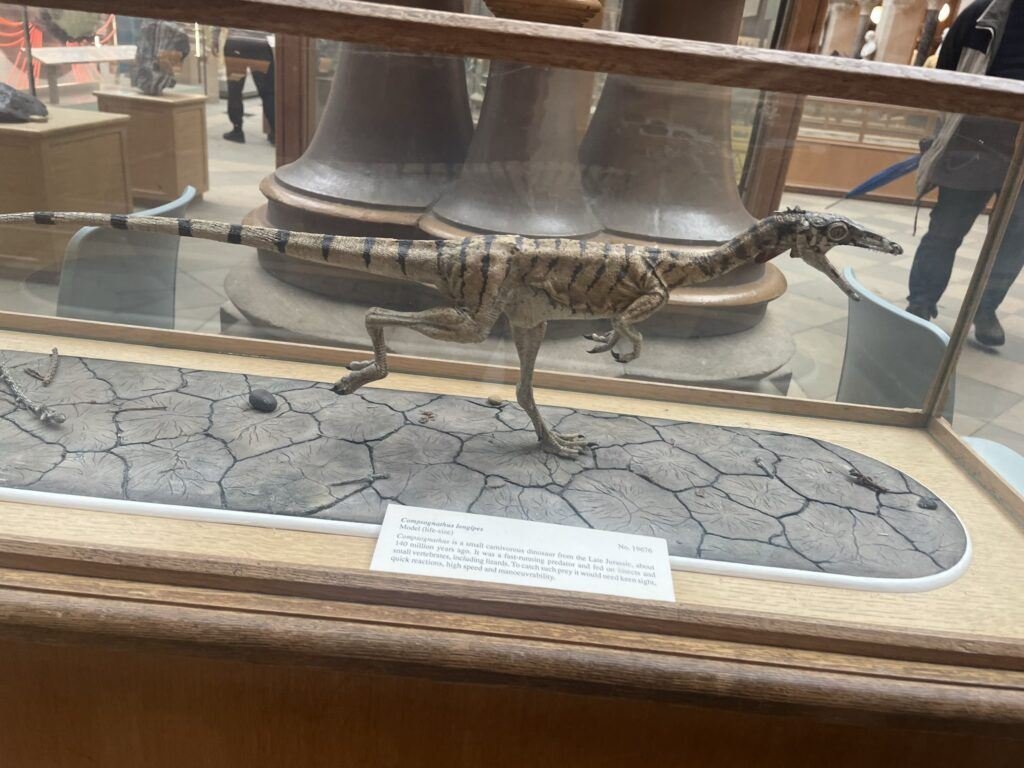

“Compsognathus longipes No.19676
Model (life-size)
Compsognathus is a small carnivorous dinosaur from the Late Jurassic, about 140 million years ago. It was a fast-running predator and fed on insects and small vertebrates, including lizards. To catch such prey it would need keen sight, quick reactions, high speed and manoeuvrability.”
Allosaurus
Almost as famous as T rex, Allosaurus has seen a resurgence in popularity in recent years, thanks to being featured among a variety of other dinosaur species in the Jurassic World franchise.
Looking at this Allosaurus’ skull, you can immediately see the different shape from looking head-on. It looks much more slender, I think (this could be due to the way the animal died though, as shown below).
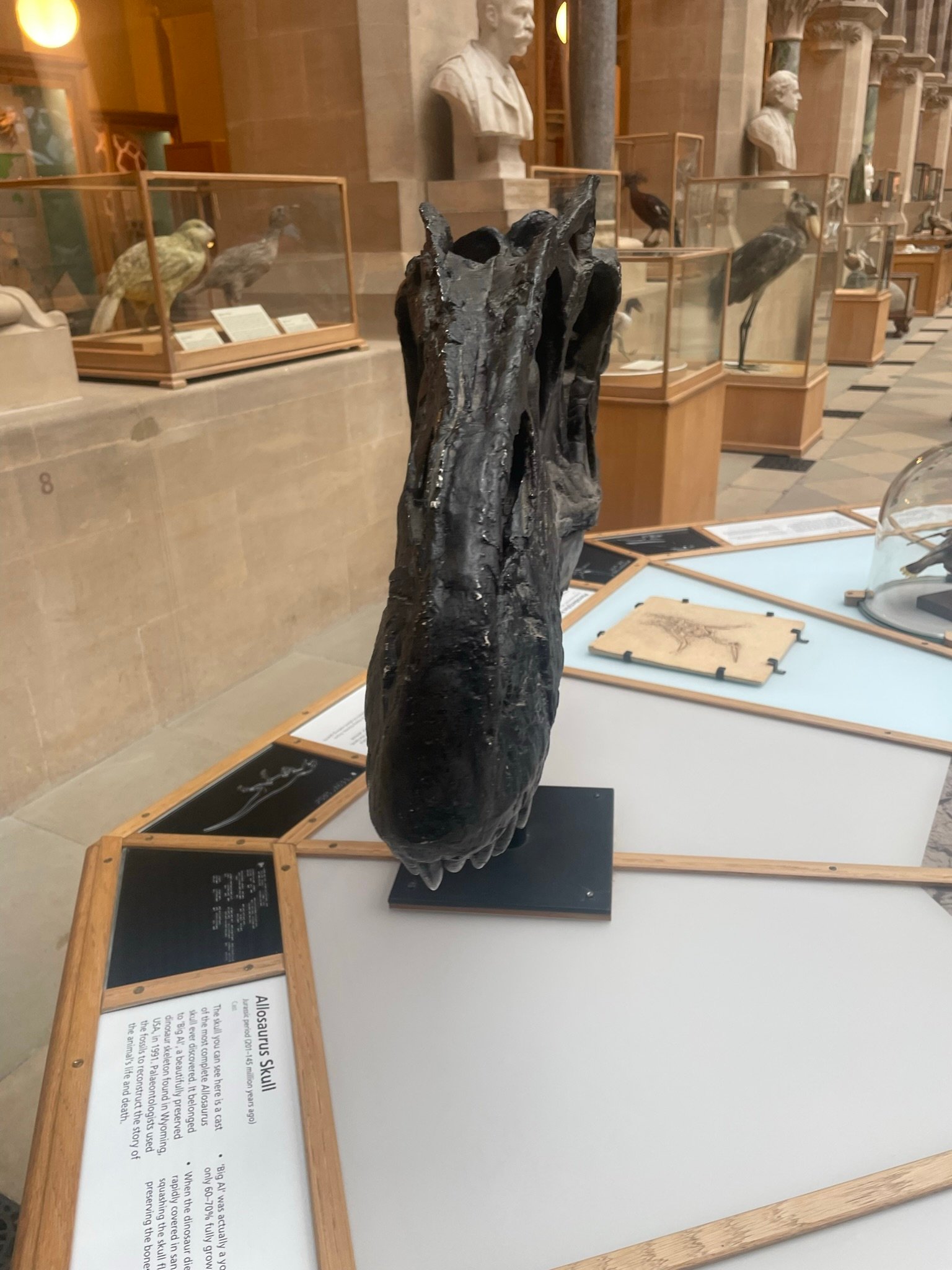


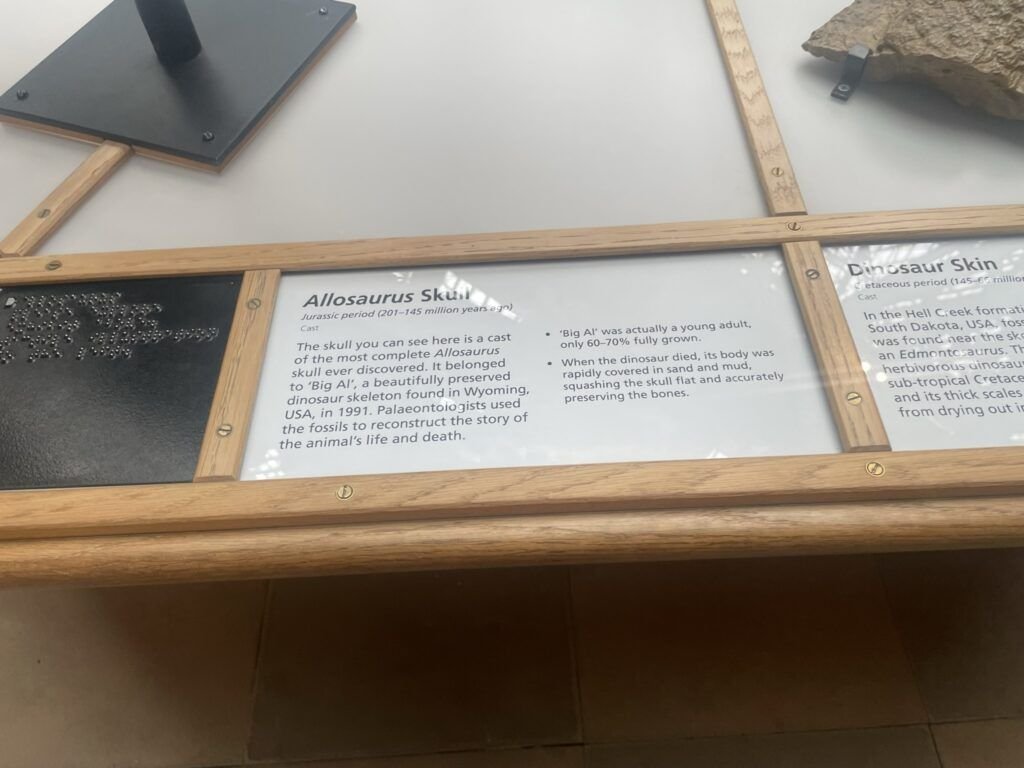

“Allosaurus Skull
Jurassic Period (201 – 145 million years ago)
Cast
The skull you can see here is a cast of the most complete Allosaurus skull ever discovered. It belonged to ‘Big Al’, a beautifully preserved dinosaur skeleton found in Wyoming, USA, in 1991. Palaeontologists used the fossils to reconstruct the story of the animal’s life and death.
‘Big Al’ was actually a young adult, only 60 -70% fully grown.
When the dinosaur died, its body was rapidly covered in sand and mud, squashing the skull flat and accurately preserving the bones.”
Pachycephalosaurus
Standing shoulder height against an average human, these things were likely as dangerous as any meat-eating dinosaur if you were to meet any. With a 9-10″ thick skull, these things were clearly tough and not afraid to use their heads in combat! Whether they used them for defence against predators or for mating rituals or dominance, I wouldn’t want to get too close to one…

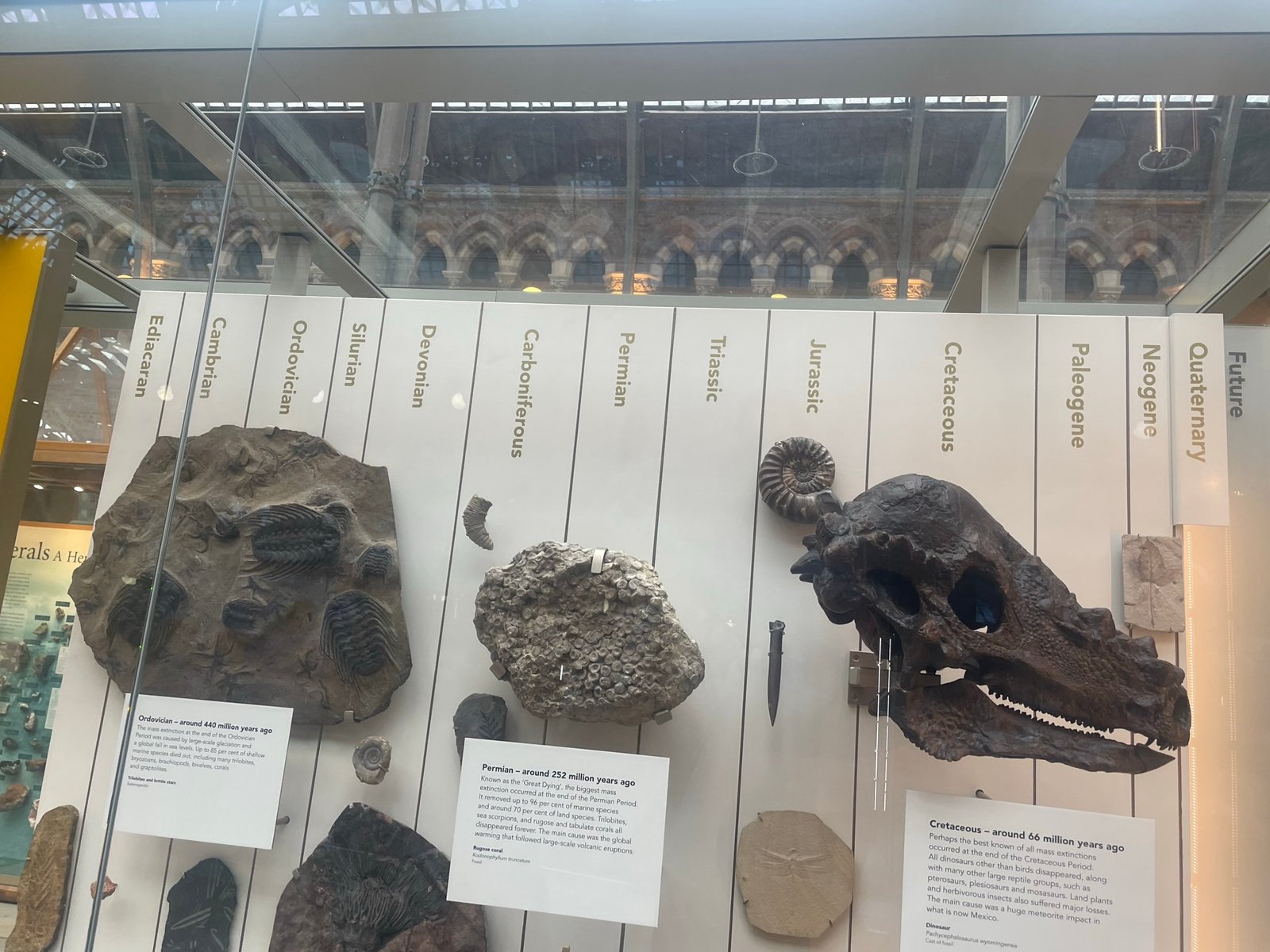
There was no fact file for this hardcore dinosaur, just the species name and type of display:
Cretaceous – around 66 million years ago
Dinosaur
Pachycephalosaurus wyomingsis
Cast of fossil
Edmontosaurus
Maybe not one of the most famous of the “duck-billed” dinosaurs, but one look at the skull gives you a clue as to where they get the name.
This was likely in the large herbivore niche that zebras, wildebeest and buffalo fall into now, if you can compare such a different time as simply as that. This dinosaur was preyed upon by none other than the Tyrant Kings (and Queens) themselves, the T rex.



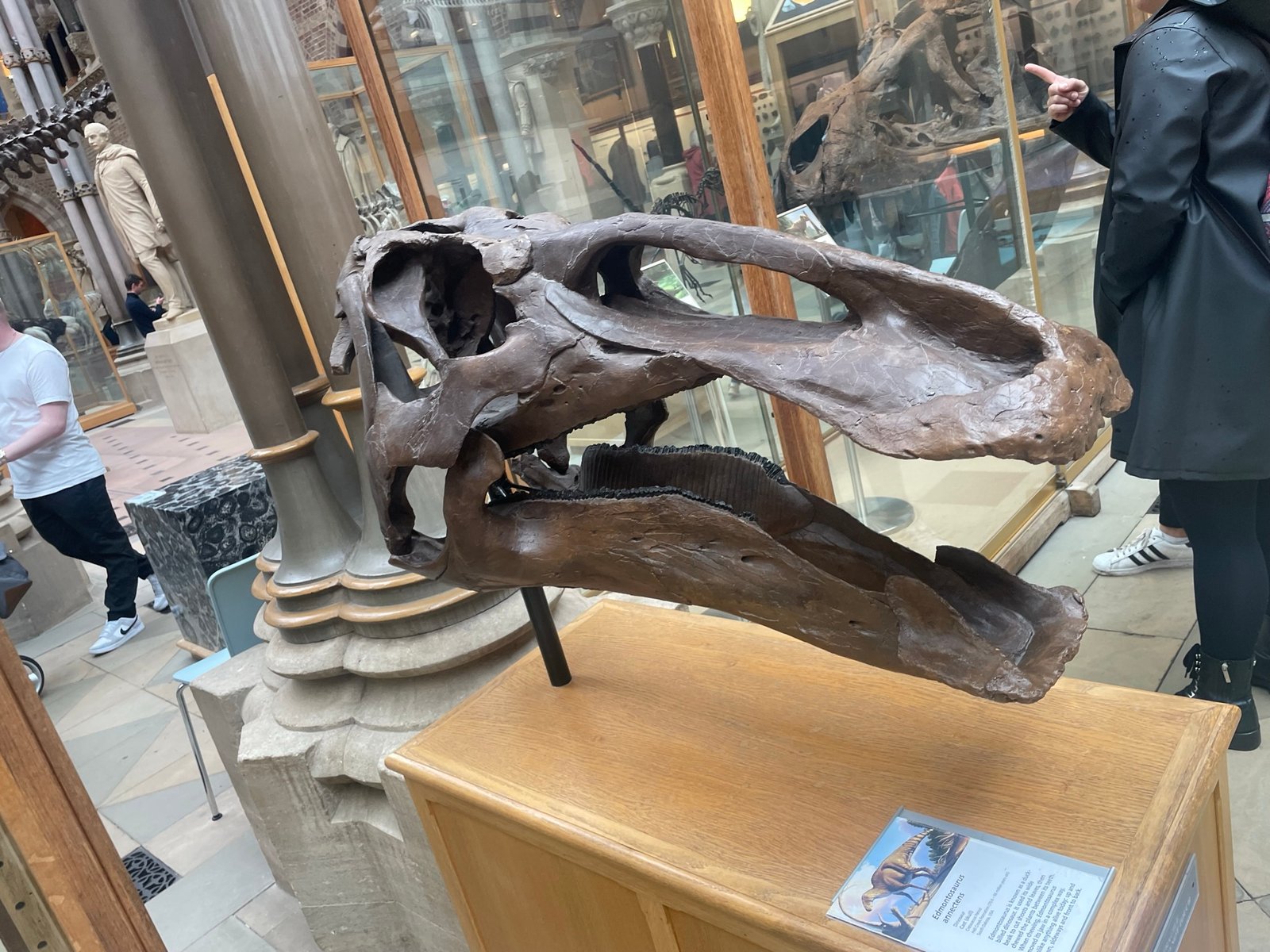
“Edmontosaurus
annectens
Dinosaur
Cast (Skull)
Cretaceous Period
Hell Creek Formation (70.6 – 66 million years ago)
South Dakota, USA
Edmontosaurus is known as a duck-billed dinosaur. It used its wide beak cut shoots and leaves, then chewed the plants between its teeth.
When chewing, Edmontosaurus moved its jaw in complex way, unlike anything alive today; up and down, sideways and front to back.”
Struthiomimus
This agile, long-legged dinosaur is likely to have moved in a similar manner to how Gallimimus is portrayed in Jurassic Park and Jurassic World – like huge, leathery as well as feathered Ostriches.

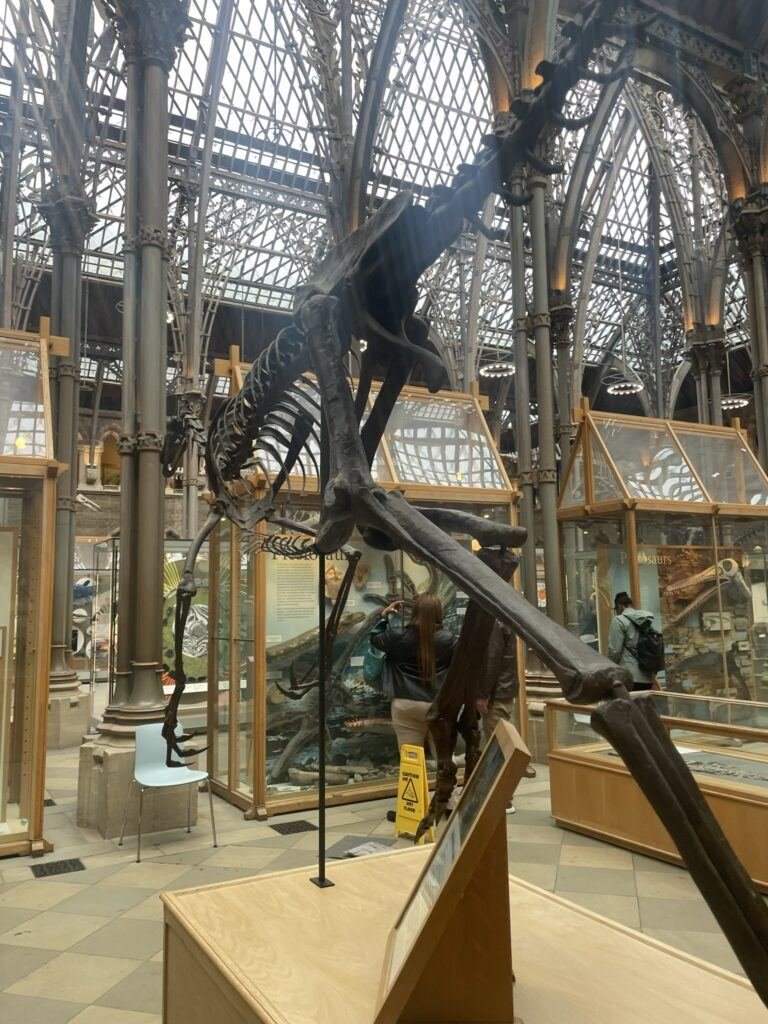
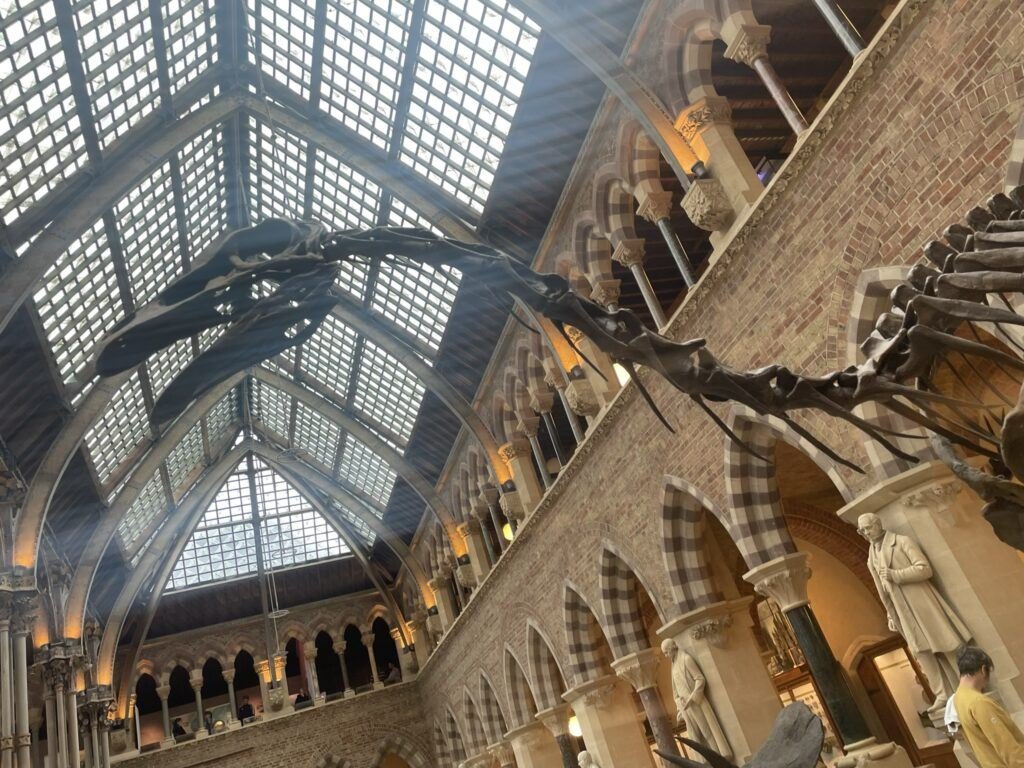

“Struthiomimus sedens
Dinosaur
Cast (Skeleton)
Cretaceous Period
Lance Formation (70.6 – 66 million years old)
Wyoming, USA
The name Struthiomimus means ‘ostrich mimic’. As the name suggests, Struthiomimus has a lot in common with an ostrich. Like an ostrich, Struthiomimus had a beak without any teeth and it had feathers, which probably looked very similar to a modern-day ostrich’s.
However, there are still several differences between this dinosaur and a bird. Struthiomimus had a long bony tail, like other dinosaur, whereas ostriches have lost their bony tails, like other birds. Instead of wings, Struthiomimus had fingers that ended in sharp claws.”
Triceratops
As much as only the skull of Triceratops was on display, this was more than enough to convey what an awe-inspiring animal this was, I cannot imagine the evolutionary pressures that meant this dinosaur weaponised its face to this extent. Probably a combination of mating displays and defence against predators, I would imagine.
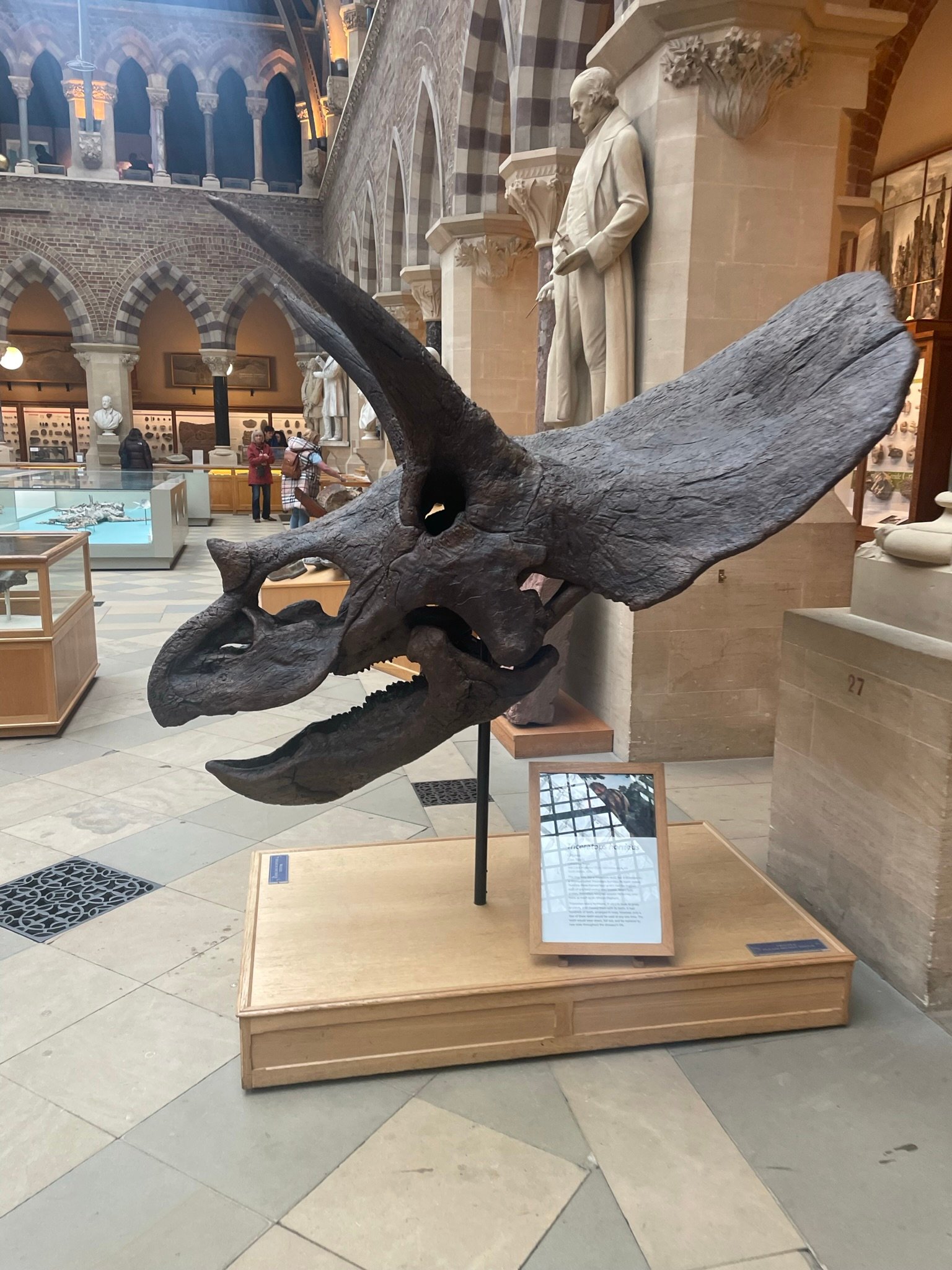


“Triceratops horridus
Dinosaur
Cast (Skull)
Cretaceous Period
Hell Creek Formation (70.6 – 66 million years old)
South Dakota, USA
This may look like a rhinoceros skull, but it belonged to a dinosaur called Triceratops horridus. Its name means ‘horrible three-horned face’ and it had the biggest skull of any land animal ever known. When fully grown, Triceratops weighed around 14 tonnes, over twice as much as an African Elephant.
Triceratops was a herbivore. It used its beak to grasp at plants, and chewed them with its teeth. It had hundreds of teeth, arranged in rows. However, only a few of these teeth would have been used at any one time. The teeth would wear down, fall out, and be replaced by new ones throughout the dinosaur’s life.”
Bambiraptor



“Bambiraptor feinbergi
Dinosaur
Cast (Skeleton)
Cretaceous Period
Two Medicine Formation (84.9 – 70.6 million years old),
Montana, USA
Not all dinosaurs were enormous. When fully grown, Bambiraptor would only have been the size of a turkey. But that doesn’t mean it wasn’t a fierce predator; it hunted smaller animals and scavenged for carcasses.
Bambiraptor was closely related to the famous Velociraptor and they both belonged to the family of dinosaurs called the dromaeosaurs. The dromaeosaurs shared several features with their relatives the birds, including a wishbone, air-filled bones and feathers.
This particular skeleton is from a young dinosaur, so it was named after the Disney character Bambi.”
This will definitely not be the last time we go to the Oxford Natural History Museum, and we will soon be covering another museum in Oxfordshire that has a garden full of replica dinosaurs – not to mention the Natural History Museum in London, so there will be more to come!
